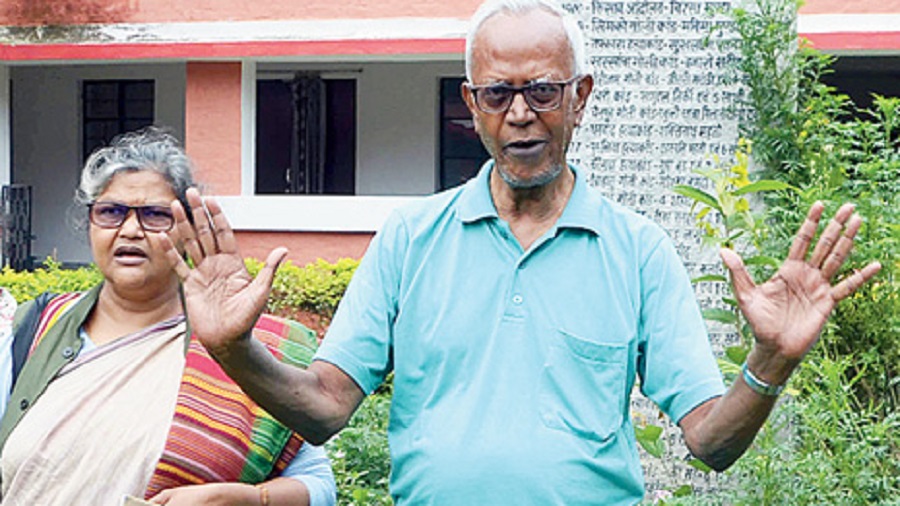I have never met Father Stan Swamy or any of his alleged co-conspirators. Like most other people, I have only read about them and their alleged conspiracies to destabilize the Republic in the media. As also the threat they pose to my safety for which they must be incarcerated. They must stay unfree, says the State. And who are we to question that profound wisdom? The State is eminent domain; it must have had its reasons for holding an eighty-four-year-old priest in a cell and denying him a chance to access bail. Many commentators have analysed this and pointed out the maladies of our time.
But knowing all this does not assuage my inner self. Father Stan’s death haunts me as if it’s a personal loss. Why do I think that I knew him when I clearly did not? Probably because I had met soft-spoken but upright Jesuits like him when I was an undergraduate student in St Xavier’s College. People who could rise above their religious affiliation and extend a hand across the divisions of our society. As far as I can see, we are mourning not only the passing away of a gentle priest but the death of people who can stand with courage and conviction to build a mosaic of togetherness.
Stan Swamy’s death points out to us that we have lost very many elements of what it means to be human — sympathy for the poor and the underprivileged and the resolve to defend and articulate their concerns. And, yet, we are also without a doubt a more prosperous India than, say, even three decades ago. Not that this prosperity has been distributed well for inequality among the classes has grown. Nor have we been able to create and distribute basic welfare facilities — education, health and shelter for those who are in need. What we have managed well, however, is to create an all-consuming, aspirational middle class with authoritarian streaks that has thrown up a greater number of social pathologies than ever before. It is this sense of loss that we mourn when we remember Stan Swamy and the denial of basic human dignity to an old man. We also grieve for the passing away of the symbols of a past life that we may never recover.
The question is not only who killed Father Stan Swamy but also what dies along with him. What are the causes that have led to the current state of affairs that Indians find themselves in? If we were to ask these questions and answer them honestly, then it would be clear that Father Stan’s death symbolizes both the rot that has set in and our collective failure to break out of the mould of self-absorption. This new, self-absorbed individual is the outcome of our honeymoon with the neoliberal world, for every age must produce — sociologically — the character of the times. The dominant theme today is the celebration of a compassionless, egoistical human being. This unconcern with our fellow citizens must not be argued away as the manifestation of our ‘natural selves’ in the manner that the 17th-century English philosopher, Thomas Hobbes, had done. This new, brutish, self-absorbed man is the product of careful grooming and pedagogy. His persona is a socialized self, but it is emerging with a difference. For the emergent self is no longer capable of thinking collectively, of listening patiently, and sympathizing or empathizing with the victims created by the system.
In our quest for economic growth, in our obsession with technology as a panacea for our problems, we have managed to normalize the marginality of the people who have been dispossessed of their land, livelihood and sustenance. The pattern that has developed over the years has a singular storyline: the prosperity of a few must be subsidized and sustained by the many marginalized, indigenous people. This story is not only true of India but also for most of the world. What is worrisome is our collective inability to spot this injustice and take corrective steps. Our unreflective selves have been shaped and transformed by a model of learning and pedagogy where we ‘see’ but are not ‘observant’, we ‘hear’ but do not ‘understand’. What Father Stan and his resistance did is bring to our notice those whom we have consigned to our amnesia, thereby disturbing our exclusive comfort zones of high consumption and spending.
The question that is critical here is whether we can recover, even partially, a more sensitive, caring self. To do that, we need to embark upon a reorientation of our teaching and learning processes, of investing time and money in subjects that would allow us to be critical and compassionate. The recovery of our collective self cannot be based upon ideas that are the causes of our failures but by allowing for a more reflexive self to evolve through a dialogic process that acknowledges the world as plural and diverse. Rabindranath Tagore did precisely this by creating Santiniketan, where one moved out of the confines of the ‘mainstream’ to learn about the world we inhabit. Later, in different countries and at different times, the likes of Ivan Illich and Paulo Freire made similar efforts. It is no coincidence that Father Stan was a student of Paulo Freire.
It is for us now to take up the unfinished projects that would lead us to the ‘pedagogy(ies) of the oppressed’ so that we may not belittle the struggles of those whom we invariably leave behind in our singular quest for ‘success’. While we know who killed the good Jesuit, we have to look inside us to discover the accomplices of his killers.











